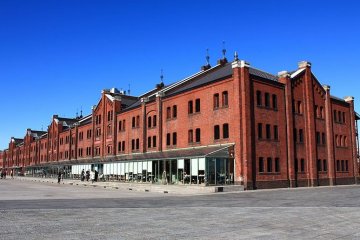
La Croisière du Thé à Yokohama
Tomoko KamishimaLa croisière du thé à Yokohama : le Royal Wing est un navire de croisière qui arrive et part du terminal maritime international de passagers de Yokohama.

Yokohama International Passenger Terminal, also known as Osanbashi or Yokohama Port, is located at Osanbashi Pier. Osanbashi Pier, located between Minato Mirai and Yamashita Park / Chinatown, is the most important international port terminal for Japan due to its proximity to Tokyo many cruise lines from around the world stop by.
The 400 meter long pier has walkways and green spaces that are open to the public. It was originally built in 1894, but converted into a passenger terminal in 2002. The pier is one of the best places in Yokohama to get an unobstructed view of the Minato Mirai skyline. There are also shops, restaurants and a hall for small exhibitions and events here.
By train, Osanbashi Pier can be reached via a seven-minute walk from Nihon-Odori Station (Minato Mirai Line) or 15-minute walk from Kannai Station (JR, Yokohama Subway). By bus, Osanbashi Pier is accessible via the Akai Kutsu sightseeing bus (stop C15), from the Motomachi/Chinatown area heading towards Sakuragicho Station. On foot, Osanbashi Pier can be easily accessed from nearby sightseeing spots, between Yamashita Park and the Minato Mirai. The Akarenga Red Brick Warehouse is a 10-minute walk.

La croisière du thé à Yokohama : le Royal Wing est un navire de croisière qui arrive et part du terminal maritime international de passagers de Yokohama.

L'endroit le plus romantique de Yokohama? Sans hésitation, la jetée d'Osanbashi. Et même si vous êtes seul, en famille ou entre amis, l'endroit est tout de même magnifique, et tout de même romantique.

Bien qu'il existe plusieurs circuits de croisière à Yokohama, je veux vous présenter le bateau le plus fantastique — le Royal Wing

L'hôtel MyStays Yokohama, la localisation parfaite pour explorer le bord de mer.

Idéal pour les couples ou les groupes (jusqu'à 12 personnes), Masago propose une cuisine kaiseki savoureuse, délicieuse et artistique. Essayez leur cuisine classique de style japonais qui a été modifiée pour un goût plus international tout en conservant l'harmonie de ses saveurs originales.

Profitez d'un après-midi de thé chinois avec dim sum, shumai et boulettes de pâte à MS. CASABLANCA. Cet espace de restauration chinois décontracté est chic et confortable, offrant une cuisine chinoise haut de gamme à Kanagawa.

Le Peace Cafe propose un menu végétalien délicieux et coloré. Vous ne serez pas déçu par le café d'inspiration hawaïenne où vous pourrez goûter la salade de tacos mexicaine, le tofu-katsu et le curry avec une ration supplémentaire de légumes.

When Japan opened its market to the rest of the world in the late 19th century, Yokohama was the main port through which trade flowed to the Tokyo area. The red brick warehouse, also known as Akarenga, was opened during the Meiji -Time built in support of the port of Yokohama, it served as a customs clearance point to control the flow of goods through the port. Nowadays it has various shops and restaurants. The Event Plaza hosts markets and other outdoor celebrations. In addition, the warehouse has several event halls for concerts, exhibitions and more. The Red Brick Park also offers a spacious area of grass where you can relax and have a beautiful view of the bay and the passing ships.

Considéré comme le premier parc côtier du Japon, le parc Yamashita est situé juste en face du port de Yokohama, s'étendant sur près de 700m du côté est d'Osanbashi à la jetée de Yamashita. Il a été créé à partir des restes de bâtiments détruits lors du grand tremblement de terre de Kanto et a ouvert en 1930. Le parc comprend une prairie d'herbe, une roseraie, la statue de la «Petite fille aux chaussures rouges», la statue «Gardien de l'eau», qui est un cadeau de San Diego, ville jumelle de Yokohama, et le mémorial de la chanson «Kamome no Suihei-san "(" Seagull Sailor "), un escalier d'eau et une scène. L'ancien cargo et navire à passagers Hikawamaru est ancré ici.

Yokohama Park is the second oldest park in Yokohama after Yamate Park and was opened to the public in 1897. With the construction of Yokohama Stadium, the dilapidated facilities of the park were renovated and a Japanese garden-style pond and creek, a fountain and a river were renovated Multipurpose space expanded. Around 140,000 tulips of around 70 varieties will be planted in Yokohama Park in November. The flowering time varies depending on the variety, but depending on the weather, the tulips are usually in full bloom from the beginning to the end of April. The park is a particularly popular travel destination at this time.